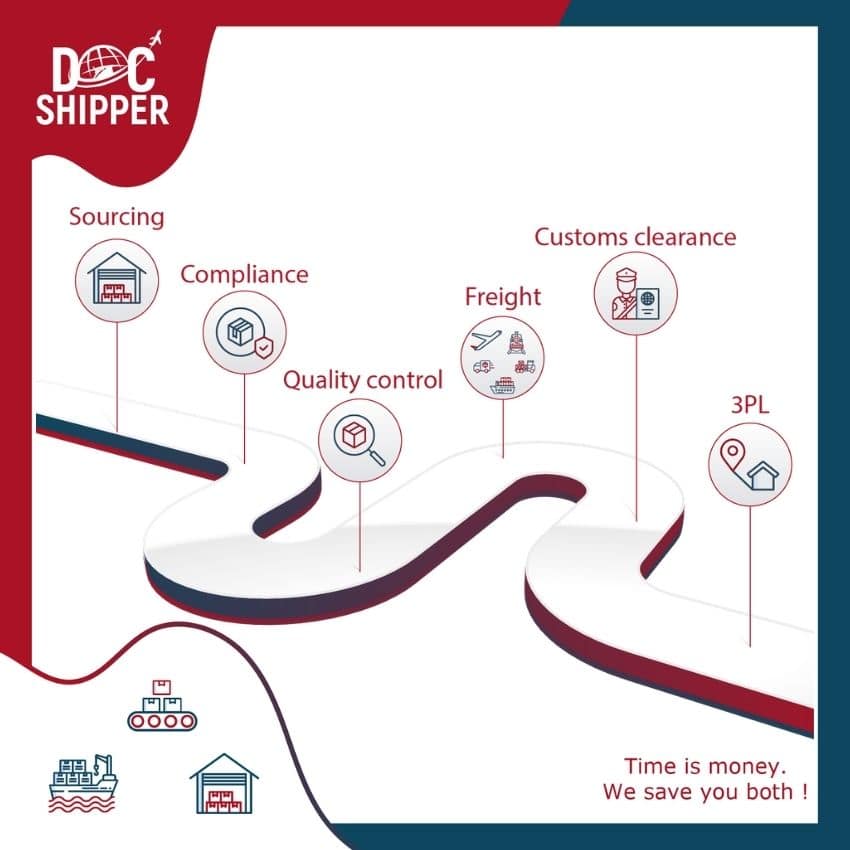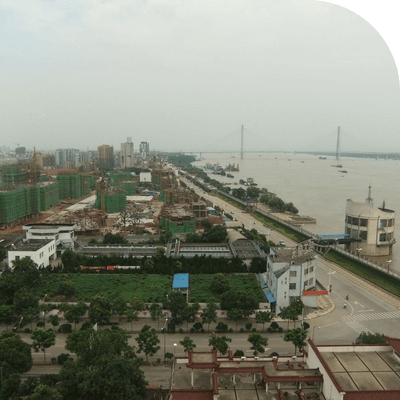Importing products from China can be a complex process, and it's important to understand the tax obligations that may apply no matter where you are located in the world. Customs duties, VAT (value-added tax), quotas, and licenses are just some of the factors to consider.
Don't risk being caught off guard by unexpected fees and charges!
Customs clearance is a mandatory process when importing goods from China to any country, and taxes will be applied to your cargo. These taxes are collected by the customs authorities of the destination country and are calculated based on the declared value of your goods.
In this page, we will explain how DocShipper can assist you with customs clearance services from China to anywhere in the world. We'll also provide guidance on how to estimate customs duties and taxes for your Chinese imports, as well as the necessary documents and requirements for a smooth import process.
Whether you're based in the EU, US, UK, Australia, Russia or anywhere else, this guide is designed to help you navigate the customs clearance process with confidence. Enjoy reading!
DocShipper Advice : At DocShipper, we are here to help you import your products from China in a professional and efficient manner. We take care of all the steps, including customs clearance. We work with licensed customs declarants to provide you with a compliant service and avoid delays and extra costs. By working with us, you can concentrate on your business without worrying about administrative and technical formalities. Contact us for more information.
Customs clearance services from China - How to estimate customs duties and taxes for Chinese imports ?
If you are thinking of shopping outside Europe or importing goods from China, you may think that your purchases will be tax-free.
But this is not entirely true. You may be subject to customs duties, particularly for customs clearing imports into China, which many people tend to overlook. Customs duties are mandatory for most importers and can have a significant impact on your overall costs. It is essential to include this tax in your business model and not just focus on VAT.
Calculating customs duties can be complex and difficult, but it is essential to understand how they work. In this article we will explain what customs duties are, how they are calculated and why they are essential.
DocShipper Alert : These rates are not easy to predict because they are constantly fluctuating depending on a multitude of points: trade agreements between countries, monitoring of quotas, the status of the importer, country of origin... And because things would be too easy if they were stable, customs duties also change over time and with temporary and/or transitional amendments.
Docshipper Tips : The value retained by customs officials is what is known as the CIF value, i.e. it also includes international freight charges in the loadable (customs) value. CIF is an incoterm that includes the entire shipping process from departure to the destination terminal (port, airport, or station).
Step 1 - Getting the HS Code
The HS Code is an identifier composed of numbers only and which allows customs officials (worldwide) to identify simply and quickly the nature of the products in your cargo.

Normally, your supplier should be able to provide you with the HS Code. If not, you can still find it on your own. You can go to this U.S. government site to type in your keywords and find the HS Code that matches your keywords: HTS - HS code finder
Here's a simulation using the same pineapple example :

Still having trouble finding the HS Code? Please contact us !
Step 2 - Determining Customs Duties
We will guide you step by step on how you can determine the future taxes on your cargo :
- Go to the European Customs website at the following link: : TARIC System European Customs or American :
- Then click on the yellow button in the middle " ACCESS TO DATABASE "
- Once you have arrived on the TARIC system, fill in your HS code as well as the country of origin. It should look like this:
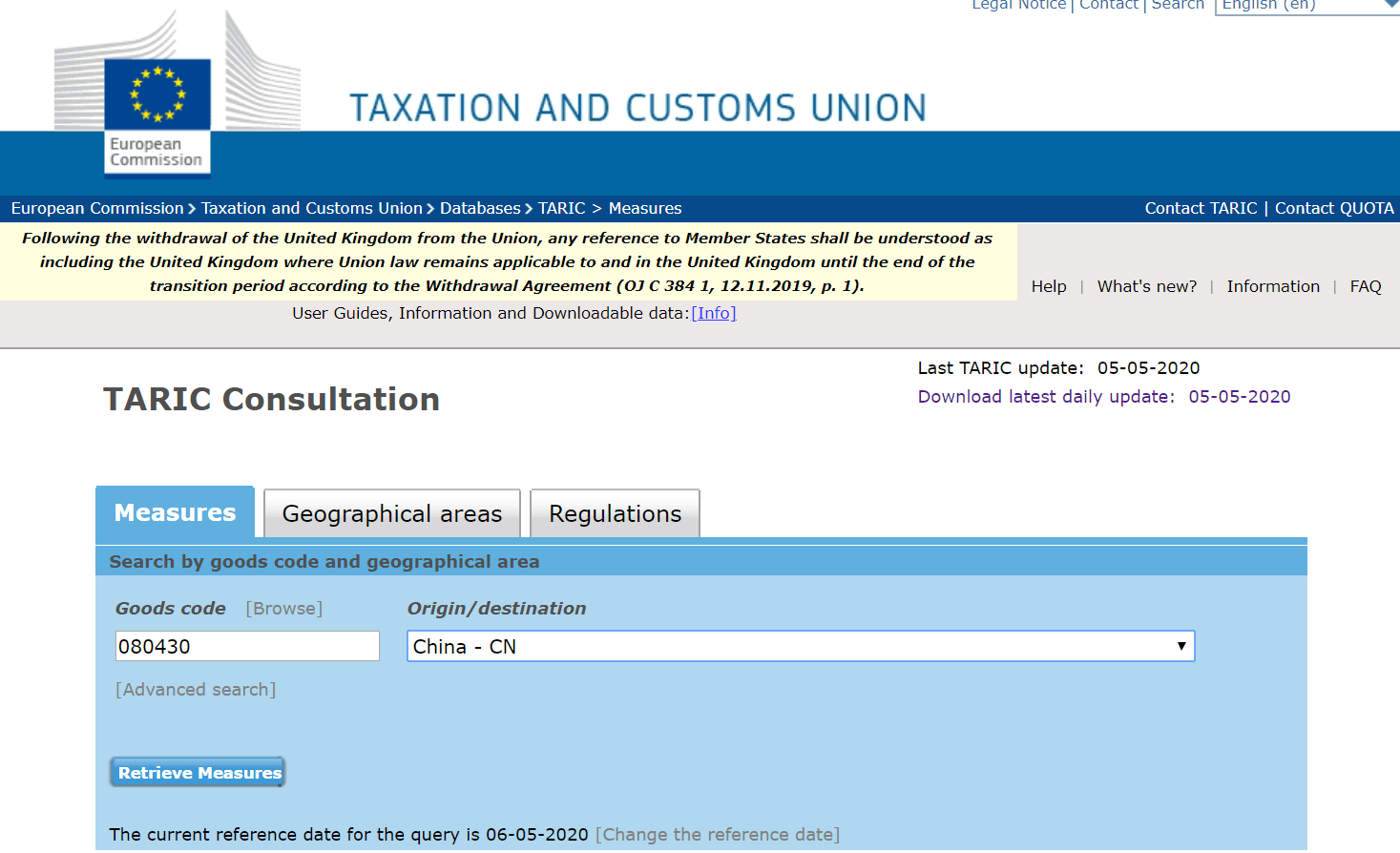
- Did you enter your HS Code and country of origin correctly? Now click on "Search for measurements".
- Check that the HS Code matches with your product and then read the duty, you'll need to find something like this :

- Would you like more information? Then click on the blue link as shown in the screenshot just above, you should come across an official document, in our case it's more than 1000 pages long!
DocShipper Note: Having a problem finding the HS Code or customs duties? Do not hesitate to contact our experts for assistance with tax evaluation during customs clearance.
Step 3 - Assessing the value for duty
As mentioned above, customs duties and taxes will be indexed to the so-called "customs value". It is important to estimate the value of duty in order to avoid unpleasant surprises on the day.
The customs value is the CIF value, i.e. it includes not only the price of the goods but also the price of the international freight to the customs clearance terminal as well as insurance costs.

Want to learn more about incoterms (like CIF)? Feel free to have a look at this article from our branch in Vietnam : Incoterms 2020

VAT - Value Added Taxes
VAT is a must, so you need to clarify this situation so that you don't have any unpleasant surprises in your cash flow.
Before going into the explanation, you can directly read this article about import duty from USA.
VAT when importing in Europe
Taxe base
The taxable amount on which VAT must be calculated when goods are imported from outside the EU is the value defined as the customs value of the goods.
If they are not already included in the customs value, are included :
- Taxes, duties, levies and other charges that are due outside the EU country of import
- Ancillary costs, such as commission, packaging ...
- Incidental costs arising from transport to another place of destination within the EU, if the latter place is known at the time of the chargeable event.
Minimum VAT rates
The standard rate cannot be less than 15% ;
EU countries may also apply one or two reduced rates, which must not be less than 5% and which will only be applied to very specific supplies of goods. The directive allows the application of a reduced rate of at least 12%.
VAT when importing in USA
TAXES: In the United States, there is no VAT to be paid when importing a part. However, there is a fee for processing the goods. An "MPF" - Merchandise Processing Fee - is a duty imposed by U.S. Customs and Border Protection (U.S. Customs and Border Protection or "CBP") on most U.S. imports. The MPF is charged at 0.3456% of the value of the imported merchandise with a minimum fee of $25 and a maximum fee of $485 for official entries.
CUSTOMS DUTIES: As in all countries, duties differ according to the type of merchandise. HS codes, which are tariff codes, are used in the United States to categorize the type of item. You can find all the information on HS codes on the U.S. Government Census website here.
When you import products from outside the European Union, the VAT on the products is collected during the customs clearance period. Only after payment of customs duties and VAT will your goods be released and legally resold on the mainland.
Companies can include the VAT paid during customs clearance directly in the turnover declaration to avoid a disbursement.
Eligible companies
Of course, not all companies are eligible for this tax advantage. Here are the 2 conditions of eligibility:
- Companies established on the territory of the European Union
- Companies subject to VAT in the European Union (with representative office and/or local subsidiary)
Docshipper Tip : Each country legislates its taxation differently, including exceptions. For example, in the case of France, some companies are under the Simplified Taxation Regime (RSI) and therefore have a very specific regulation. Contact us for more information.
How can I pay less tax?
There is no real leeway on the customs duties and taxes you will pay when you import your products. Some will tell you that it is possible to under-declare goods (indicate a value lower than the actual value). Yes it is possible but it is dangerous and we do not advise it!
It is indeed possible to ask your supplier to send documents (including the "packing list" and the "purchase invoice") showing a value lower than what you actually paid. Those who attempt such a manipulation risk 2 types of problems:
- Customs penalties: revaluation of your cargo, customs inspection fees, storage and handling...
- Reimbursement of disputes: in case of a dispute, your insurance will only reimburse up to the value indicated on the transport documents.
Tables for estimating customs duties and taxes (Europe)
Recent products
Rates applicable in 2022 - Commission Implementing Regulation (EU) 2022/ of 21 November 2022
| Goods to be declared at customs | Customs duties | VAT | Customs Nomenclature | |
|---|---|---|---|---|
| Shoes | 0 % | 20 % | 4417 | |
| Electric Scooter | 0 % | 20 % |
|
|
| Connected Watch | 3 % | 20 % |
|
It is possible that some products are not taxed in China. Recently in 2022, children's products, medical products, some electronic components or leather products such as bags are no longer taxed by customs.
Note that tax exemptions can be temporary and customs rules can change quickly. It is therefore important to find out about the latest customs policies in China before importing products.
Electronic equipment: camera, camcorder, computer, games...
Rates applicable in 2020 - Commission Implementing Regulation [EU] 2019/1776 of 9 October 2019
| Goods to be declared at customs | Customs duties | VAT | Customs Nomenclature |
|---|---|---|---|
| Tactile tablets | 0 % | 20 % | 8471 30 00 |
| Laptop | 0 % | 20 % | 8471 30 00 |
| Smartphone | 0 % | 20 % | 8517 12 00 |
| Hands-free kits for mobile phones | 0 % | 20 % | 8517 62 00 |
| Digital cameras and camcorders | from 0% to 1.6%. (at 0.8% as of July 1, 2020) |
20 % | 8525 80 .. |
| Game consoles | 0 % | 20 % | 9504 50 00 |
| Recorded DVD/Blu-ray | 0 % | 20 % | 8523 49 10 |
| Electronic toys | from 0 % to 4,7 % | 20 % | 9503 00 21 à 9503 00 99 |
| Electronic games (like Sudoku) | 0 % | 20 % | 9504 90 80 |
| Portable color television set (small TV with antenna) and television receiver screen | 14 % | 20 % | 8528 72 .. |
| Electronic breathalyzer | 0 % | 20 % | 9027 10 10 |
| GPS navigation system | 0 % | 20 % | 8526 91 20 |
Tables for estimating duties and taxes on the basis of the Common Customs Tariff, for electronic products
Musical instruments: piano, string or wind instruments
Rates applicable in 2020 - Commission Implementing Regulation [EU] 2019/1776 of 9 October 2019
| Goods to be declared at customs | Custom duties | VAT | Customs Nomenclature |
|---|---|---|---|
| Musical instruments | from 3,2 % to 4 % | 20 % | from 9201 .. .. to 9207 .. .. |
Tables estimating duties and taxes on the basis of the Common Customs Tariff, for musical instruments
Horlogerie & jewelry
Rates applicable in 2020 - Commission Implementing Regulation [EU] 2019/1776 of 9 October 2019
| Goods to be declared at customs | Custom duties | VAT | Customs Nomenclature |
|---|---|---|---|
| Wrist watch | 4,5 %, with : a minimum of 0,3 € / piece and a maximum of 0,8 € / piece | 20 % | from 9101 .. .. to 9102 .. .. |
| Articles of jewelry and parts thereof of precious metal, whether or not coated, plated or lined with precious metal | 2,5 % | 20 % | 7113 1. .. |
| Costume jewellery | 4 % | 20 % | 7117 .. .. |
Estimation tables of duties and taxes on the basis of the Common Customs Tariff, for watches, jewellery, etc.
Carpets and floor coverings
Rates applicable in 2020 - Commission Implementing Regulation [EU] 2019/1776 of 9 October 2019
The quality of the carpet's construction, texture and composition influence the customs rates.
| Goods to be declared at customs | Custom duties | VAT | Customs Nomenclature |
|---|---|---|---|
| Carpets known as "kelim" or "kilim", "schumacks" or "soumak", "karamanie" and similar hand-woven carpets | 3 % | 20 % | 5702 10 00 |
| Coconut floor coverings | 4 % | 20 % | 5702 20 00 |
| Carpets and other textile floor coverings, tufted, whether or not made up | 8 % | 20 % | 5703 .. .. |
Tables estimating duties and taxes on the basis of the Common Customs Tariff, for carpets and floor coverings
Clothing
Rates applicable in 2020 - Commission Implementing Regulation [EU] 2019/1776 of 9 October 2019
Travellers' attention is drawn to the range of rates for clothing imports: 12 per cent in general (highest rate), but varying between 6.3 per cent and 12 per cent.
| Goods to be declared at customs | Custom duties | VAT | Customs Nomenclature |
|---|---|---|---|
| Knitted or crocheted clothing and clothing accessories (incl. knitted or crocheted garments) | General case: 12%. (range of 8% to 12%) |
20 % | 61.. .. .. (Chapter 61) |
| Garments and clothing accessories, not knitted or crocheted (e.g. made of fabric). | General case: 12%. (range 6.3% to 12%) |
20 % | 62.. .. .. (Chapter 62) |
Tables for estimating duties and taxes on the basis of the Common Customs Tariff, for garments

Mandatory documents for customs clearance
Bill of Lading
The "bill of lading" (which can also be found under the name "B/L") is an indispensable document when it comes to international freight. While the Bill Of Lading is specifically for sea freight, we will refer to this document as the "Airway Bill" when chartering your goods by air.
In any case, the 2 documents have the same principle: they allow you to confirm the space reserved for freight and therefore the transport of goods.
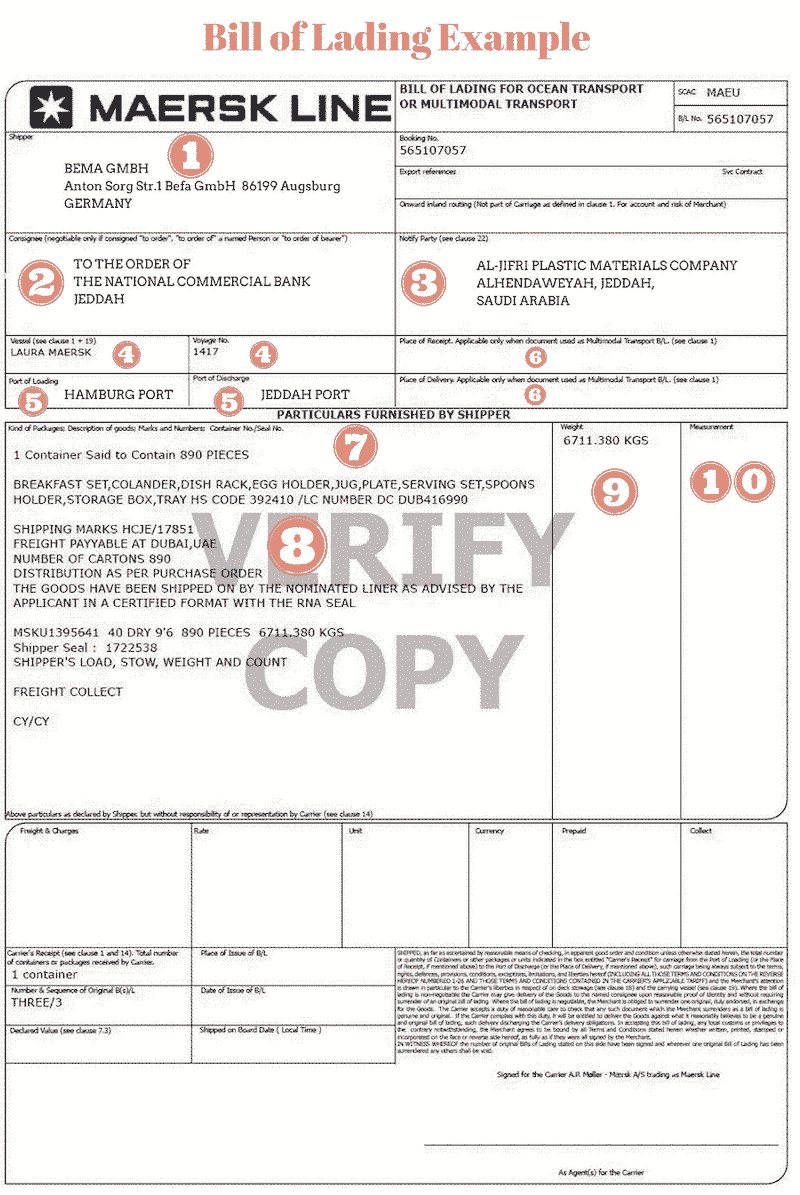
1 = Sender
2 = Recipient
3 = Notify party
4 = Vessel and voyage number
5 = Port of departure / arrival
6 = Place of departure / arrival
7 = Container number
8 = Description of goods
9 = Gross weight
10 = Dimensions
4 copies of the B/L will be printed and the original will be retained for customs clearance when the cargo is at the destination terminal.
DocShipper Advice : DocShipper handles Bill of Lading, which is an essential document for your shipment. With our expertise in international shipping, we are able to produce professional and compliant B/Ls for your shipment from China. Contact us !
Packing list
The "packing list" is one of the other essential documents when it comes to international freight. It is a document that will notably be necessary during the import customs clearance phase but also to make the export declaration.
The packing list provides a multitude of information such as :
- The purchase incoterm
- Terms of payment
- Information on the product(s), in particular weight, volume, description, etc.
- Declared value of products and total amount
- Origin and destination of cargo
- Seller and buyer information (name, address, email, phone)
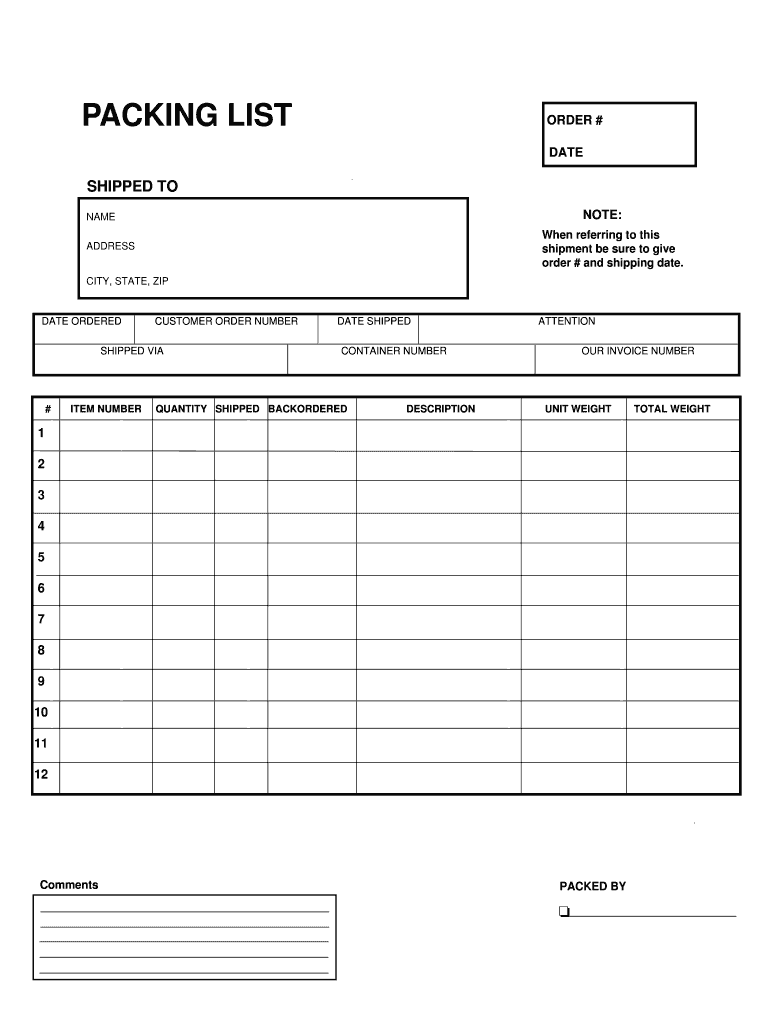
DocShipper Advice : Before starting any shipment, our import department will check your packing list to verify its conformity. All it takes is one omission, one mistake and your shipment can be blocked at customs and thus generate uncontrolled costs.
Certificate of Origine (C/O)
The Certificate of Origin (or Certificate of Origin in English) is still one of the indispensable documents to be able to ship products around the world. Indeed, it certifies that the product listed on it meets certain criteria to be considered as originating from a particular country.
Here is an example of a Certificate of Origin (Chinese):

Other mandatory documents
We have made a very condensed list of the documents you need to have during development. But beware, some shipments for specific products require very special documents. Here is a list of these documents:
- The purchase invoice
- Insurance policy
- The quota compliance certificate
- The inspection certificate
- Quality certificates
- Sanitary certificates
DocShipper Alert : Do you have sensitive or high-value products to ship and are concerned about their security during shipment ?
Don't panic, DocShipper is here to help! We offer a professional shipping service to ensure that your products are protected and delivered safely. We are experts in product-specific customs regulations and requirements and can help you obtain all the necessary documentation to ensure compliance. Contact us for more information

Product safety and compliance
When importing products from China, it is essential to understand the potential safety and compliance risks of the products you wish to import. Although many Chinese manufacturers produce quality products, it is important to be aware that some may not meet the safety and quality standards applicable to your target market. For example, electronic products such as counterfeit mobile phone chargers can be dangerous to consumers if they do not meet safety standards.

As an importer, you are responsible for the safety of the products you import, which means that you must ensure that the products meet the applicable safety standards. If they do not, you could be held responsible for any problems or damage caused to consumers. Therefore, you must ensure that the products you import meet the safety standards applicable to your target market. Compliance regulations such as FCC, RoHS and CE certifications ensure that products are safe and meet applicable standards. If you do not take these regulations into account, customs authorities may block your products and cause delays and additional costs.
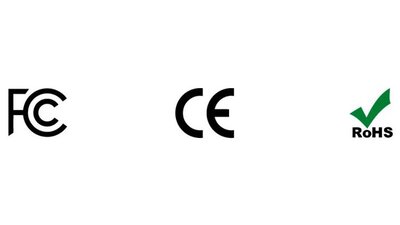
At DocShipper, we understand the potential risks associated with product non-compliance, and we offer compliance services to help you import your products legally. We can help you obtain the necessary certifications for your products, such as FCC, RoHS and CE, and meet the compliance regulations for Chinese imports.
By choosing our compliance service, you can ensure that your products meet applicable safety standards and that your import is legal and hassle-free. We understand the importance of product compliance to ensure consumer safety and avoid the additional costs of having your products blocked at customs.
EORI Number
EORI Number: What is it?
The EORI number (Economic Operators Registration and Identification Number) was introduced to identify economic operators in the EU in a uniform way, as regards their relationship and interaction with customs authorities and can be considered as a kind of "customs number".
The main idea is to simplify customs clearance, which has become increasingly automated. The EORI number is indispensable for all correspondence between the operator and the customs authorities, whether it concerns applications, declarations, or other documents.
It consists of 17 characters and generally, there are a few exceptions, the first and second characters are the country code. As a trader in Europe, you must check the validity of the number for each shipment within the customs territory of the European Union. However, private individuals are not affected by this regulation.
This is what an EORI number looks like: EN1523824912
Do not hesitate to visit an official website for more information : EORI number: how and why to obtain it?
Who needs an EORI number?
Anyone importing goods from outside the EU or exporting in the other direction must have an EORI number. It is also used by customs authorities to find out what is happening and for security, data analysis, and statistical purposes.
When moving goods within the EU or importing products for private use, no EORI number is required. However, it is still required for imports and exports within the European Economic Area.
Sometimes, companies located outside the EU but trading within Europe must also obtain an EORI number.
How to get an EORI number?
The EORI number is very easy and quick to obtain if you already have a company registered in the European Union. You will get it within a few days (depending on the member country) directly on the internet (or by mail if you prefer). Note that the EORI number you will have is unique and definitive, so you will not need to repeat the process over and over again.
Although directly related to the functioning of the European Union, the EORI number can be obtained directly from the local authorities in which your company has been registered. Here is a list of the different websites (by country) to help you apply for an EORI number:
- Austria
- Belgium
- Bulgaria
- Croatia
- Cyprus
- Czech Republic
- Danmark
- Finland
- France
- Greece
- Hungary
- Irland
- Italia
- Lettonia
- Luxemburg
- Malta
- Holland
- Poland
- Portugal
- Romania
- Slovakia
- Slovenia
- Espagna
- Sweden
- United Kingdom
How long does the EORI recording last?
After the registration process and all documents are completed, it should take no more than 3 days before you receive it by e-mail. Check your spam folder and keep in mind that this may vary from country to country.
Check the EORI number: EORI validation
Before you think about getting an EORI number, make sure you are not already registered. Some companies automatically obtain an EORI number when they register for VAT.
You can check whether your company has an EORI number with the EORI number validator provided by the authorities in many countries. You can also go to the EORI number validator provided by the European Union.
Duty free when buying in China
here is a certain amount below which you will not pay tax when you buy goods in China, which we call the "duty-free threshold". If you do not exceed the stated threshold, you will be exempt from customs duties and taxes, you will not pay any taxes!
- 150 euros for products bought in E-Commerce (For example: Aliexpress, Amazon, Made-in-China..)
- 430 euros for travellers by plane or boat
- 300 euros for passengers using other modes of transport
Are you over the deductible? Then you will have to pay customs duties and VAT as indicated above.
Customs Brokerage Services
When importing goods from China or any other country, customs clearance is a crucial step in ensuring that your goods are delivered legally. Customs authorities can be very strict when it comes to importing goods and customs clearance procedures can be complex. This is why it is important to use a professional customs clearance service to help you with this process.
It should be noted that only certified entities such as freight forwarders like DocShipper can carry out customs clearance legally. These professionals are trained to understand the rules and regulations of customs and international trade, and can provide valuable advice on the customs formalities that need to be completed. They can also facilitate communication between you, the importer, and the local customs authorities to ensure your goods are processed quickly and efficiently.
A professional customs clearance service can help you avoid costly mistakes that can occur when importing goods. By using a certified freight forwarder, you can focus on your business with confidence, knowing that your goods are in good hands.
Conclusion
As you may have read through this page, customs clearance is not a step you can afford to rush! You will have to be rigorous and meticulous throughout the entire process to avoid mistakes and/or omissions that can cost you a lot of money! A document is missing and customs officials may decide to seize the goods until they are compliant: storage fees, handling fees, etc... etc.
At DocShipper, we check all documents before departure, this is part of our company policy. It's quite simple, if we don't have the necessary documents, we won't ship your shipment!
Of course we accompany you throughout the whole process in order to obtain the missing documents if necessary!
Do you need customs clearance? Do not hesitate to contact our team at +12135505272
FAQ - Customs clearance of Chinese products
Can a private individual import ?
No problem from the moment you import products for personal use. Naturally, if you import 1000 electric bicycles (for example), it will be very difficult (if not impossible) to clear them through customs as personal effects. In this case, you will need a company and an EORI number. Use your common sense!
How to avoid disputes during customs clearance ?
It is essential to respect all the requirements coming from the customs authorities of the country of destination: documents, procedures, restrictions... Do not try to circumvent the system at the risk of taking a penalty that could hurt, very badly, your business! The best way to comply is of course to use a professional freight forwarder like DocShipper for assistance from departure to arrival (customs clearance included).
How much to pay at customs clearance ?
The customs clearance is invoiced under 2 main charges: firstly the customs clearance fees, i.e. the fact of paying the customs declarant (sworn), the establishment of the documentary bundle... Finally, you will also have to pay (except for tax exemption) customs duties and taxes. The first charge will be paid directly to the forwarder (DocShipper for example) and the second will be for the customs authorities.
How to pay customs duties and taxes ?
During the customs clearance phase, our (or another freight forwarder's) customs declarant will submit your file to local customs officials. The latter will then establish the amount of customs duties and taxes to be paid. An invoice will be provided to you so that you can pay directly for the goods in order to finalize the customs clearance and release the cargo.
How much does customs clearance cost ?
The cost of customs clearance varies depending on several factors, such as the type and value of the goods being imported, the country of origin and destination, and the mode of transportation. DocShipper, a professional customs clearance service provider, can provide you with a customized quote based on your specific needs.
Can I do customs clearance myself ?
While it is possible to do customs clearance yourself, it can be a complex and time-consuming process. There are many rules and regulations that need to be followed, and any errors or non-compliance can result in significant delays and penalties. It is often best to use a professional customs clearance service such as DocShipper to ensure that everything is done correctly and efficiently.
How long does customs clearance take in China ?
The length of time it takes for customs clearance in China can vary depending on factors such as the type of goods being imported, the complexity of the customs clearance process, and the workload of the customs officials. Generally, the process can take anywhere from a few days to several weeks. Using a professional customs clearance service like DocShipper can help to expedite the process and ensure that everything is handled correctly.
DocShipper China | Procurement - Quality control - Logistics
Alibaba, Dhgate, made-in-china... Many know of websites to get supplies in Asia, but how many have come across a scam ?! It is very risky to pay an Asian supplier halfway around the world based only on promises! DocShipper offers you complete procurement services integrating logistics needs: purchasing, quality control, customization, licensing, transport...
Communication is important, which is why we strive to discuss in the most suitable way for you!

